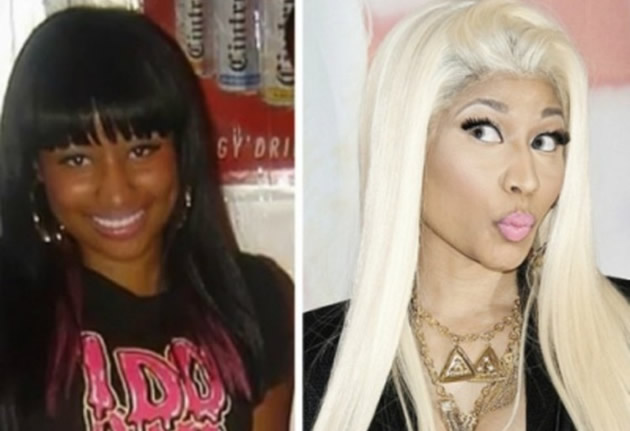The Choices we make to look beautiful


Rapper Nicki Minaj is one of the many African American celebrities believed to have used skin lightening creams to enhance their “beauty” and status
Dr Sekai Nzenza On Wednesday
“Culture must not stop us from whatever we want to look like. Life is all about personal choices. But people need to be informed about using cosmetics that are harmful to their bodies,” said my cousin Reuben, the one who is back from the Diaspora.
We were driving back from the village, as we often do. My niece Shamiso sat in the back seat, flipping through a women’s magazine that Reuben’s friends from America had brought with them around Easter.
Shamiso showed me a photo of an African American woman celebrity who had new breast implants.
There were pictures of the celebrity when she was an ordinary person, before she became famous.
The celebrity woman also had tummy tuck to stop her from having flabby bulge. I explained to Shamiso that a thickened waistline was a natural development once you are over 30 or 40 years of age and you have had children.
Some men also get a big stomach and thick waists. Getting a flab around the waistline can be resolved by eating less sadza, exercising and drinking much less alcohol. As age catches up with me, I have been reading a lot lately about living and eating healthy.
Reuben interrupted my living healthy talk and said; “The Western world has a solution for everything to do with your body and how you look. You can have a complete makeover with the use of surgery. You can increase the size your breasts, get your wrinkles straightened out and even go under the knife to get a new nose. If your hair is a natural kinky Afro like most Africans, you can also get a Brazilian weave made from real natural hair. You can also use skin lightening cream or tablets to make yourself look brown or yellow. But, most of our people are using chemicals that are harmful to their bodies.”
“I want to look like her,” Shamiso said, pointing at the celebrity woman in the magazine.
“We have already talked about this business of wanting to change yourself. What is so beautiful about that skinny body, fake long hair, fake nails, fake brown skin and fake everything?” asked my cousin Piri, who was sitting next to Shamiso in the back seat and holding baby Prince.
“Tete, you are just jealous. If you had money, would you not like to change yourself and look this glamorous? Let’s face it, light-skinned people with long hair get more opportunities. Besides, men turn their heads two or three times to look at a beautiful light skinned girl, “said Shamiso.
I recalled that skin lightening creams started during the colonial era, when women wanted to look closer to Europeans or people of mixed race. In those days, the use of skin lightening creams defined “civilisation” and progress in Rhodesia. Women and men bought products called Ambi and Butone.
Skin lightening or bleaching products were common, especially among women who lived in the city. Soon after independence there was a ban on these chemicals, because medical experts said such creams may cause cancer, diabetes, severe skin conditions and other diseases. But these cream chemicals have come back more aggressively. They are a lot cheaper and more available than before. For one dollar, you can get a small tube of cream made in India or China.
The problem of skin lightening creams is not only limited to South Africa and Zimbabwe. It is an African problem. According to a 2008 UN Environment Programme study, the use of whitening creams is most widespread in Nigeria where many women have been using them. Demand for the products is also high in Ghana, Tanzania, Congo and Kenya. Cote d’Ivoire has introduced the ban on the use of skin lightening creams because of health concerns. This ban came from the health ministry saying these creams cause serious health problems.
One British dermatologist called Justine Kluker said unregulated products which contain ingredients such as mercury or excessive amounts of steroids are placed on the free markets. She said these creams have high steroids which can cause health issues such as “acne, thinning of the skin, glaucoma or cataracts if applied near the eye . . . Or if applied liberally to the whole body, (they can) cause high blood pressure, diabetes, osteoporosis, weight gain, mood disturbance due to absorption of large amounts of steroids.”
At one time South Africa introduced the world’s toughest laws against skin lighteners, and banned hydroquinone, the most active ingredient. But that has not stopped women from using the creams. A recent study by the University of Cape Town discovered that more than a third of South African women buy the creams.
The same report showed that some creams cause blood cancers, leukemia and various types of liver and kidney diseases and a severe skin conditions or high discolouration of the skin.
“Have you seen how yellow some of the women in Africa Magic films look like?” Piri asked Shamiso. “Those women are far from looking beautiful, if you ask me. They have an orange-like skin and often wear blonde bleached hair. Their lips are naturally black because you cannot bleach lips. So they wear strong red lipstick. What nationality are those women, you might ask. You rarely ever see a natural beauty like me,” Piri said, smiling.
“I still think black is beautiful. But, if a woman wants to use creams so she can be brown, then why stop her?” Rueben said. Sometimes Reuben likes to give people choices and then take them away again.
“Nobody can stop anyone from what they want to look like. But, people are not fully informed about the bad effects of skin lightening creams,” I said.
Then I reminded them of Matinanga, the woman who used to come from our village. She was the first woman to come back from Salisbury wearing a long straight wig. Her face was no longer a smooth deep chocolate brown but it looked more of an orange or reddish colour. People pointed at her saying her face was the colour of Fanta while her legs had the colour of Coca-Cola. When Matinanga got older, she left Salisbury and came back to the village. The sun beat hard on her, as she worked in the fields like everybody else. Her cheeks had dark sunburnt patches that looked more like scars. Gradually, she looked much darker than she had ever been. Her normal smooth black skin never returned.
“Asika akambochena,” said Shamiso, meaning, at one time, Matinanag must have looked beautiful.
“It depends on what you call beautiful. We should simply accept what God wanted us to be,” said Piri. She could speak from experience. At one time, Piri used the same skin lightening creams and applied the Brazilian human hair weave and hair straightening products. People said she looked glamorous. Then her natural hair stopped growing. Now she adorns a nice short hair with small locks, often complemented by head scarfs. Life has taught her that some kinds of artificial beauty products are expensive and they only last for a short time. It is cheaper and safer to stay natural.
If only men and those we want to admire us could let go of the European notion of beauty, and accept the African person of who we are.
Dr Sekai Nzenza is a writer and cultural critic.







Comments